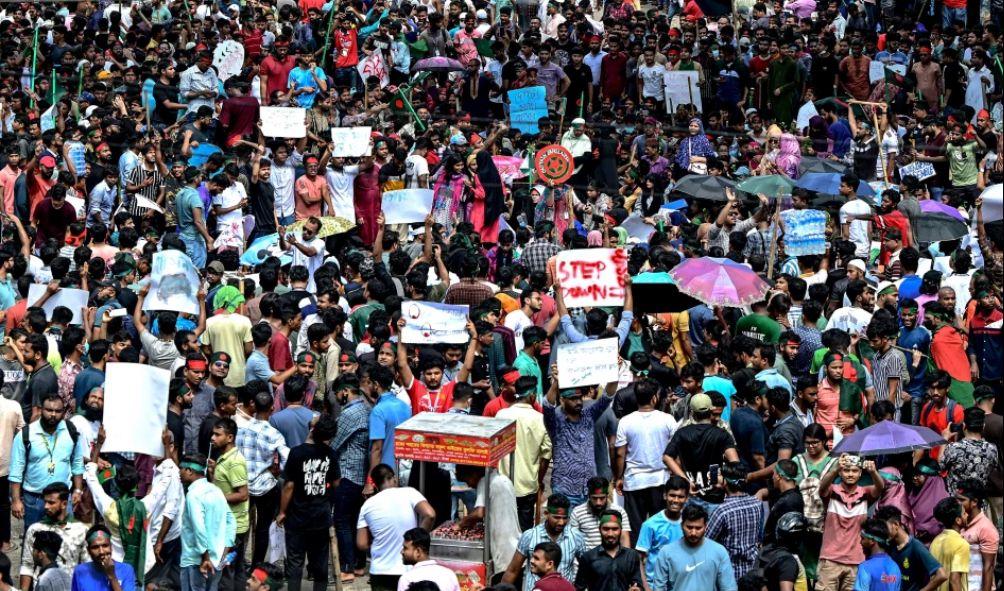How Bangladesh Uprising Toppled Hasina’s 15-Year Rule
“One, two, three, four, Sheikh Hasina is a dictator!”
This slogan had become a powerful chant among young Bangladeshis in recent weeks, culminating in the end of the prime minister’s 15-year rule on Monday.
The 76-year-old Ms. Hasina has governed the South Asian nation of 170 million with a strong grip since 2009. Just a month ago, protests demanding her resignation seemed unimaginable.
However, by Monday morning, she was caught in a lethal deadlock. The top court had annulled the job quotas that initially ignited the protests in early July, but the unrest persisted, evolving into an anti-government movement calling for her removal.
The tipping point was the intensity of the clashes between protesters and police on Sunday. The violence had claimed nearly 300 lives, with Sunday alone seeing at least 90 people, including 13 police officers, killed – marking the deadliest day of protests in Bangladesh’s recent history.
Critics labeled it “carnage,” but Ms. Hasina remained defiant.
Nevertheless, tens of thousands took to the streets on Monday, many marching towards the capital Dhaka, defying a nationwide curfew.
Bangladeshis seemed unfazed by the threat of bullets. What began as a political movement had transformed into a mass uprising.
Ms. Hasina’s decision to flee was also influenced by the military, which likely pressured her to step down. The army, having previously ruled Bangladesh and still holding significant respect and influence, plays a crucial role in the country’s politics.
The weekend violence and the likelihood of facing more massive protests would have led the military establishment to reconsider its stance.
Junior officers had already expressed concerns about firing on civilians in a meeting with the military chief, General Waker-Uz-Zaman, on Friday.
ALSO READ:
- “Two Groups, One Agenda”: Gachagua Accuses Raila of Secret Political Deals
- Exclusive: Ida Odinga’s 75th Birthday Party in Karen (Photos)
- FKF President Discloses Exact Amount Paid to Harambee Stars Players
- Gachagua’s Ally Senator John Methu Admits Ruto Might Win 2027 Elections
- Maraga Explains Why He Hasn’t Campaigned in Kisii Despite 2027 Bid
The future remains uncertain, but Gen. Zaman is reportedly in discussions with “various stakeholders,” including opposition parties and civil society groups, to find an “interim” solution, according to a high-level source familiar with the situation.
Ms. Hasina’s escape to India was expected. Although it’s unclear what advice she received from across the border, India’s giant neighbor had been a crucial ally throughout her tenure.
This alliance partly explains why, as her popularity waned, anti-India sentiment grew within Bangladesh.
India has always considered its influence in Bangladesh vital for the security of its seven landlocked northeastern states, most of which share a border with Bangladesh. Ms. Hasina had granted India transit rights to ensure goods could reach those states.
She also cracked down on anti-India militant groups based in Bangladesh, a significant issue for India.
Recently, however, Delhi faced a dilemma – supporting its unpopular ally risked alienating a massive movement and harming its long-term relationship with Bangladesh. Ms. Hasina’s resignation has resolved that issue.
As the daughter of Bangladesh’s founding president, Sheikh Hasina has been the world’s longest-serving female head of government.
Her father was assassinated along with most of her family in a military coup in 1975 – only Ms. Hasina and her younger sister survived, as they were traveling abroad at the time.
ALSO READ: Bangladesh PM Sheikh Hasina resigns, flees country as protesters storm palace(Video)
After living in exile in India, she returned to Bangladesh in 1981 and allied with other political parties to lead a popular uprising for democracy, making her a national icon.
Ms. Hasina was first elected to power in 1996 but lost to her rival Begum Khaleda Zia of the Bangladesh Nationalist Party (BNP) in 2001.
She regained power in 2009 in elections held under a caretaker government.
Her tenure was marked by allegations of forced disappearances, extrajudicial killings, and suppression of opposition figures and critics – allegations she denied, often accusing the main opposition parties of inciting protests.
Recently, Ms. Hasina and her party, the Awami League, also blamed their political opponents for the unrest gripping the country.
However, this time, the dissent was louder than ever. It was the most significant challenge Ms. Hasina, who won a disputed election in January that the opposition boycotted, had faced during her years in office.
For weeks, she refused to yield, even labeling the protesters as “terrorists” at one point.
But the realization that the security forces could not keep people off the streets was a dire sign for any leader, especially an embattled one.
How Bangladesh Uprising Toppled Hasina’s 15-Year Rule
